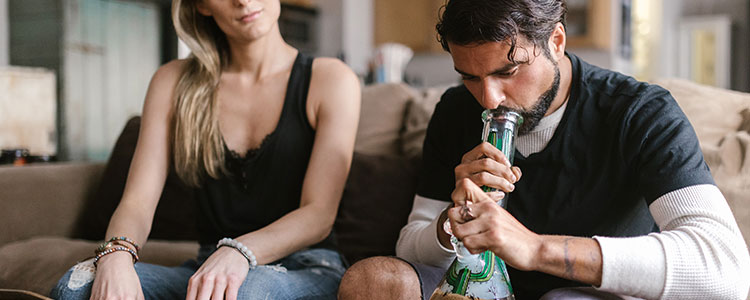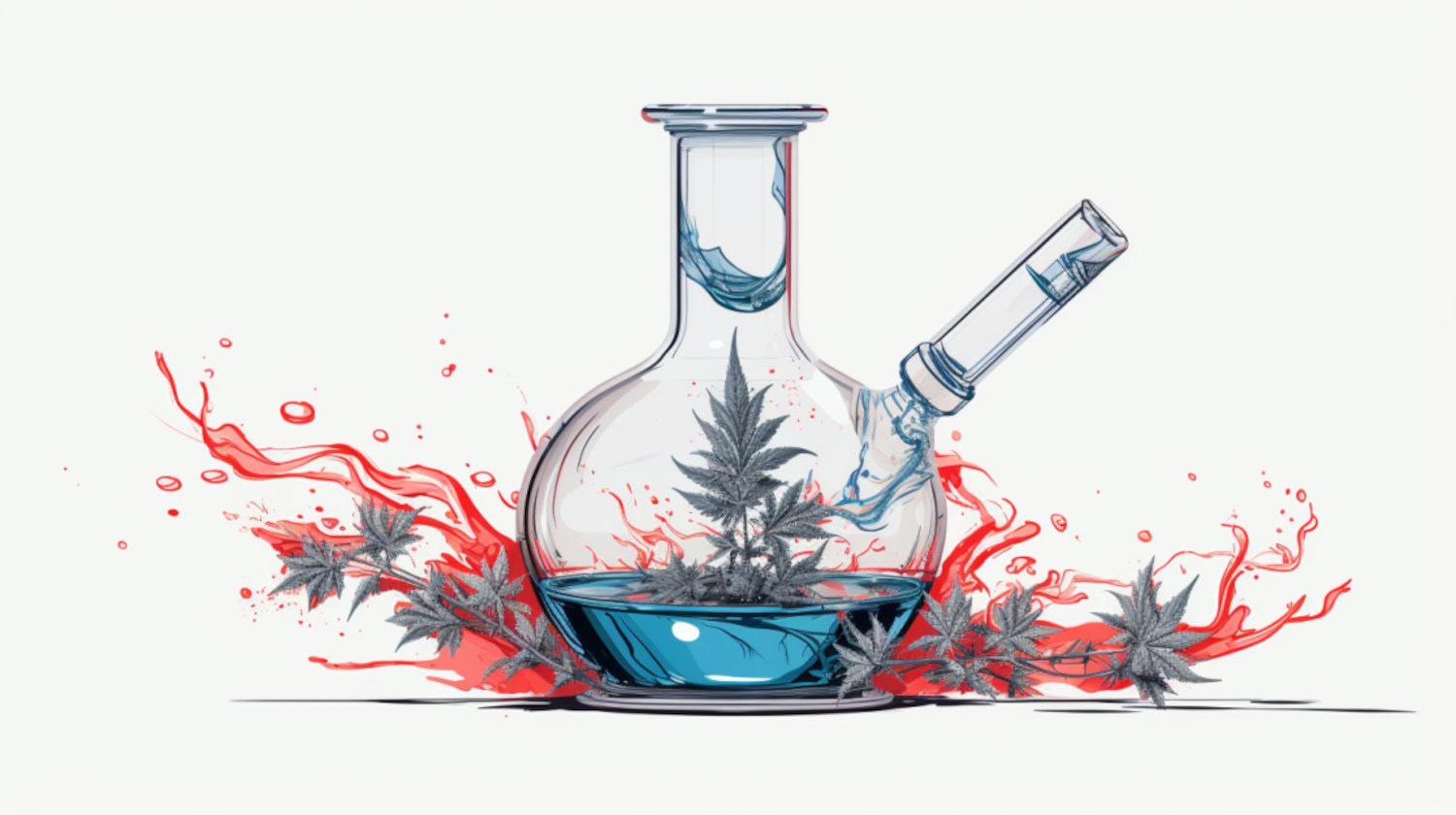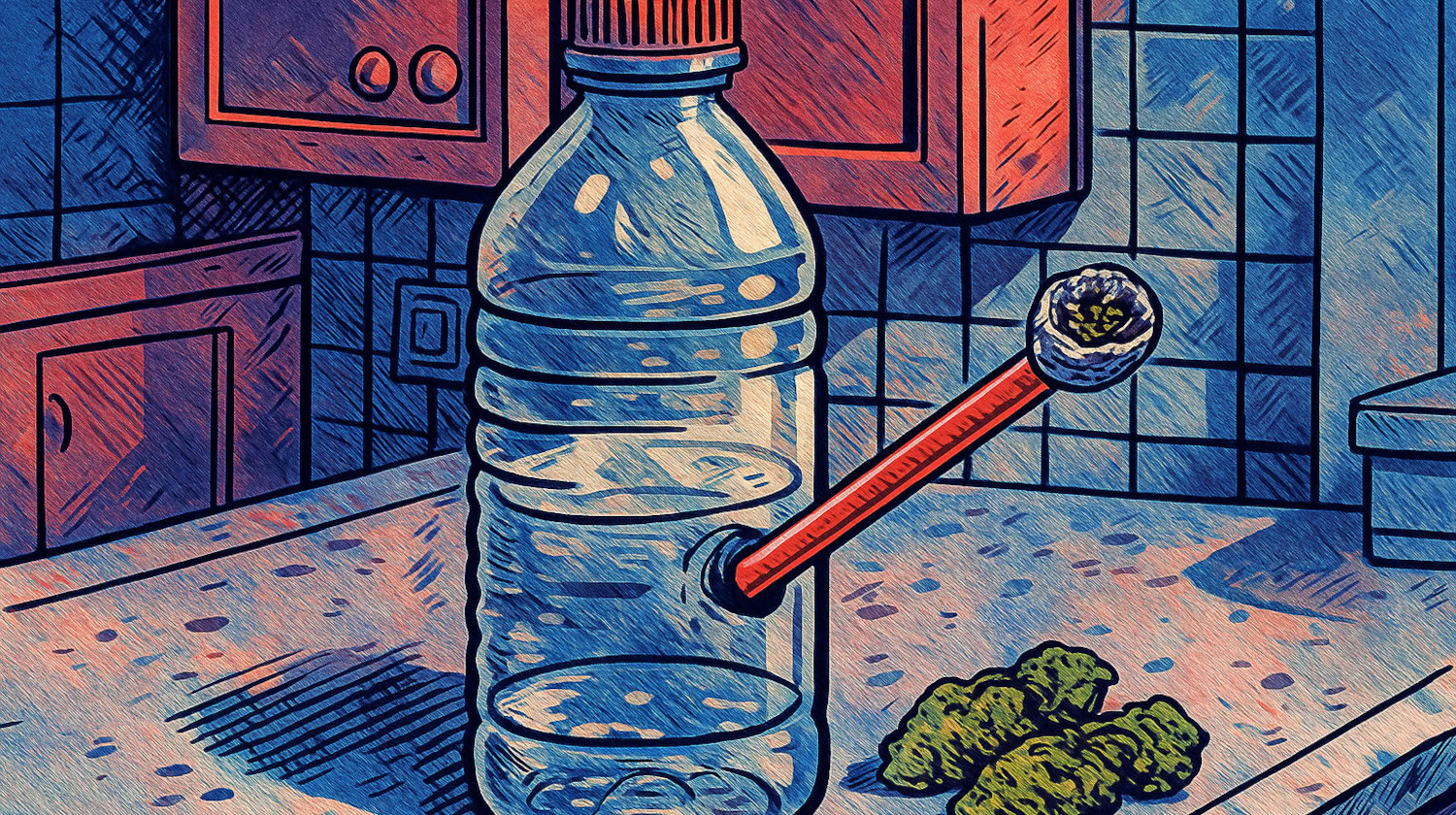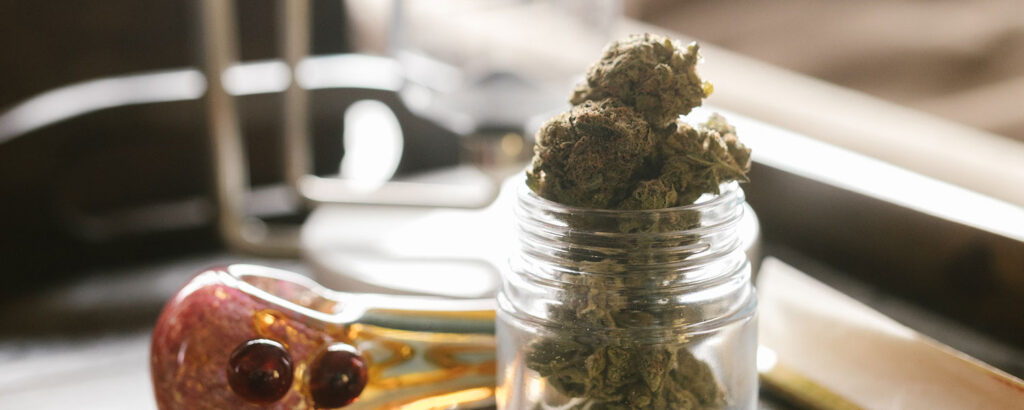In This Article
Key Takeaways
- Fill the bong with water until the downstem is submerged.
- Grind and pack your cannabis into the bowl, ensuring it’s not too tight.
- Light the bowl while inhaling slowly, then clear the chamber by removing the bowl or releasing the carb.
Many cannabis users rave about using a bong to smoke weed. It can take a few tries to get used to how a bong works, but once you get the hang of it, it can be an easy, quick way to get an elevated experience with more flavorful, full, and smooth hits of your favorite cannabis strains.
If it's your first time using a bong, read on for step-by-step instructions.
What is a Bong (and How Does It Work)?
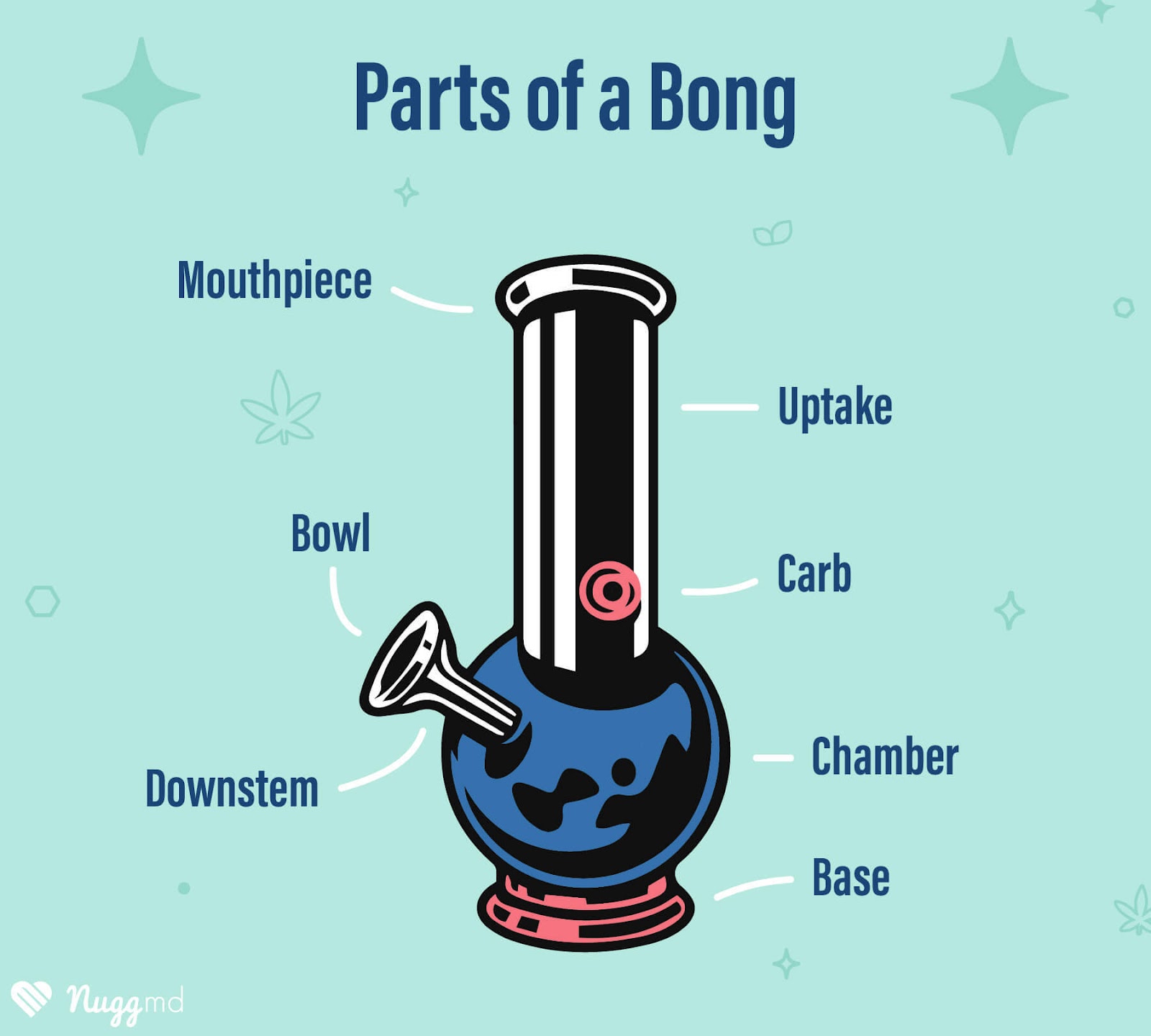
A bong is a classic smoking device, typically made of glass, silicone, or plastic/acrylic. Many people love it because it lets them get cleaner, full-bodied, potent 'hits' of their favorite dry herb.
The designs and features of these pieces can get complex, but a basic bong has the following components:
- Mouthpiece. Where smoke comes through and where you'll place your mouth.
- Uptake. The cylinder area where the filtered smoke gathers for inhalation.
- Chamber. Where the water sits and the smoke filters through.
- Bowl. A spherical cap-like piece that holds the cannabis material. At the base is a small hole for airflow.
- Carb. This can be a hole in the bong's bowl or base. If you can’t find a carb, the bowl is most likely able to slide out from the down stem. The hole where the bowl sits will act as the carb to regulate airflow.
- Downstem. This pulls the smoke from the bowl through the water into the chamber.
Other features found on bongs can be a percolator to filter the smoke, an ice catcher to prevent ice from getting into the neck, or diffused down stems that create more bubbles. These features can make for smoother, cooler smoke.
Bongs require you to light the cannabis flower with a flame, using a lighter or hemp wick. The flame will cause the cannabis to combust and turn into smoke, and the smoke will travel through the down stem into and through the water. The water feature is why a bong is also known as a "water pipe." Water pipes have been used for cannabis and tobacco for thousands of years. Traditional bongs, or water pipes, are different than waterfall grav bongs.
Studies done in the 1960s² and 70s³ found that water filters some of the toxic chemicals that come from igniting plant materials like weed and tobacco.12 In 1993, a researcher at the Multidisciplinary Association for Psychedelic Studies (MAPS) concluded that the severity of the harmful effects of smoking is unique to the individual and their habit, but water pipes may be the better mode of consumption for smokers.
Although any type of smoke has adverse effects on lung health, many cannabis smokers opt to use bongs as the 'healthier' alternative to smoking joints, blunts, or pipes. To add more filtration layers, some people add salt to the water or ice to the neck, which is why some bongs are made with built-in ice catchers.
What You Need to Use a Bong
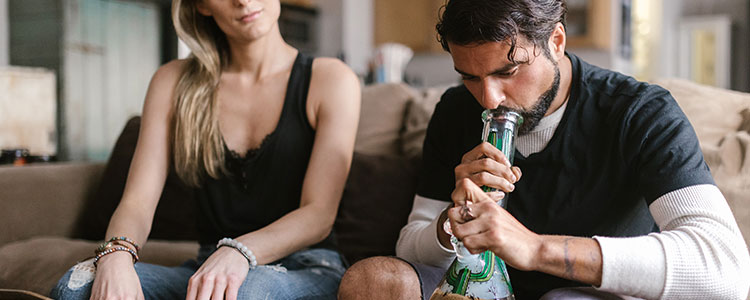
Using a bong can be a quick and easy way to get to your desired intoxicating effects. You will need the following materials:
- A bong. Make sure if you're purchasing one for the first time it comes with the body, bowl, and down stem. Sometimes they are sold separately.
- Water. How much water you'll need will depend on the bong size. It should be enough to fill the base slightly past the down stem but not high enough to reach the bowl.
- Ice (optional). If the bong has an ice catcher, you can add ice for cooler smoke and greater filtration.
- Cannabis Material. Bong bowls are filled or 'packed' with dry cannabis flower. If you'd like, you can add different concentrates on top of the flower to enhance the flavor and potency.
- Grinder (optional). The cannabis material should be broken down into smaller pieces. You can use a grinder to do this, but it's not necessary. You may also break the buds down with tools like scissors, a knife, and even your fingers.
- Lighter. A butane lighter of your preference.
- Hemp Wick (optional). Hemp wick has a lower temperature flame than directly using a butane lighter on the flower. This lower temperature can provide a more flavorful smoke. The hemp wick will also stay lit until blown out, which allows you to use the flame for more than one hit. Although, for bong hits, many consumers only need one hit at a time and will blow out the wick after one use.
- Tamping Tool (optional). You can use a specific tool for tamping the cannabis material in the bowl, but it's not necessary. Most people use the edge of their lighter or their fingers to pack the bowl as they smoke it. Don’t pack too tightly, though, or you may have more difficulty pulling the smoke from the bowl into the chamber.
- Bowl Screen (optional). Most bong bowls have a hole small enough to prevent flower from coming through the down stem, but screens add an extra layer of prevention and filtration.
- Rolling Tray (optional). Some people will use a rolling tray to break down their flower and pack the bowl to keep their table clean.
- Scooping Spoon (optional). Most consumers use their fingers to pinch weed into the bowl. A tiny spoon can be helpful if you want to keep your fingers clean while packing the bowl.
Step-by-Step Instructions to Use a Bong
Start by filling the bong's chamber with water until the downstem is just submerged. Grind your cannabis to a medium consistency and gently pack it into the bowl—firm enough to stay in place but loose enough for air to pass through. Once prepared, place your mouth on the mouthpiece, light the bowl, and inhale slowly to draw the smoke through the water.
1. Prepare Your Bong
Before you begin, ensure you're in a comfortable setting and have all your materials ready. You'll need:
- a clean bong (with the down stem and bowl),
- water (you can use tap or bottled),
- dry cannabis flower,
- a lighter.
Next, fill the bong's base with water through the mouth hole and chamber. How much water you'll need will depend on the size of your bong, but the general rule is to fill until the down stem is slightly submerged but not so high that the water reaches the bowl.
You can add ice to the water for a cooler and more filtered smoke, add salt to the water to help keep the bong clean, or add a screen to the bowl for greater filtration. But these steps are all optional.
2. Grind the Cannabis
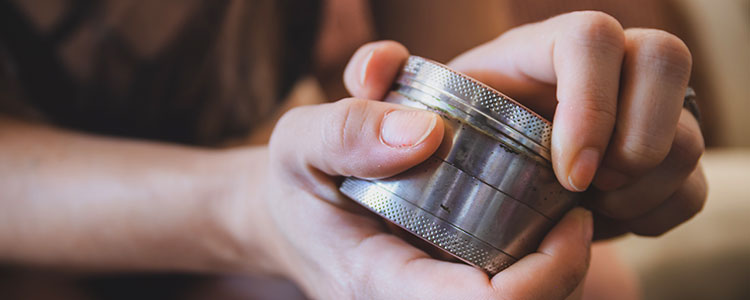
The cannabis flower will need to be broken down from larger nugs into smaller pieces. You can purchase pre-ground flower or shake from some dispensaries, or use a grinder. Some grinders have a kief catcher, allowing you to quickly and easily add kief to the top of your bowl to add flavor and potency.
Avoid grinding your cannabis too finely, especially if you don't have a screen on your bowl, as cannabis that’s too fine can fall through the down stem, creating clogs or wasting good product.
If you don't have a grinder, you can use your fingers. This is where a rolling tray may come in handy to catch the weed as you break it up.
3. Place the Ground Weed Into the Bowl
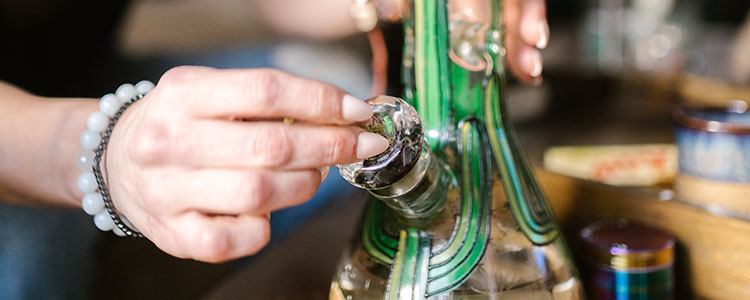
It's best to pack the bowl as it sits in the bong, but you can also remove it if you'd like. You can use your fingers or a small scoop to transfer the flower from your grinder or rolling tray into the bowl.
If you're smoking alone, you might not need to fill the bowl to the top. Bongs can deliver potent hits, and sometimes only one or two are needed to get your desired effects. As you fill the bowl, you can use a tamping tool or lighter to pack the bowl firmly (but not too tight or it may reduce airflow).
4. Get Ready to Light Your Bong
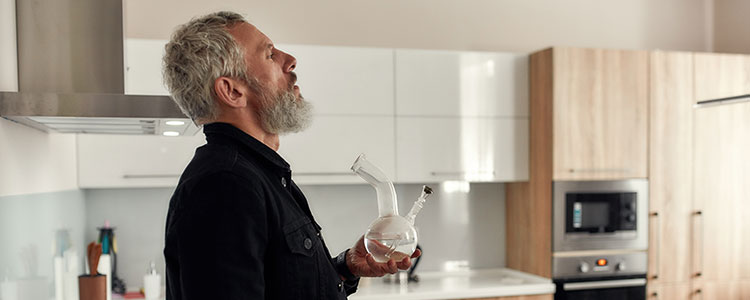
Once the bong has water and the bowl is packed, you're ready to smoke. Because bongs can hit harder than other types of cannabis consumption, it is best to start sitting down in case you feel light-headed. Make sure your lighter or hemp wick is ready, and have a beverage nearby in case you start coughing.
5. Take a Pull from the Bong
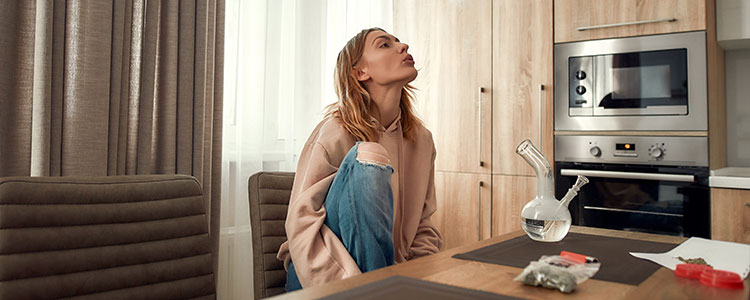
Hold the bong by the neck with your non-dominant hand, and place your mouth on the mouth hole. Your lips should be on the inside of the rim, closing any gaps where smoke might escape. If your bong has a carb hole on the base, you'll want to cover this with a finger on your non-dominant hand as well.
With your lighter or hemp wick in your dominant hand, place the flame to the dry flower in the bowl, being mindful not to 'torch' or burn the entire bowl surface. This can cause excess smoke and a larger hit than needed, especially if it's your first time. Try to 'corner' the bowl, slightly touching the flame to the edges of the flower in the bowl. You'll only need to hold the flame for a few seconds while simultaneously taking a slow inhale. Do not max out your lungs. You'll need some air for the final pull of smoke.
You will hear the water bubble while pulling the smoke through the downstem, and the chamber will start to fill with smoke. Beginners should stop inhaling when the chamber is about halfway full. Then you can either remove your finger from the carb hole or slide the bowl (bong bowls usually come with an extended lip for this purpose) out of the down stem. You can now finish inhaling the smoke.
If your lungs fill before you can 'clear' or remove all the smoke from the chamber, don't worry, you can place the bowl back in the down stem and put a hand over the mouthpiece to preserve the smoke. Exhale your first hit. Then, when you're ready to clear the chamber, remove your hand and the bowl again, place your lips on the mouthpiece, and inhale the remaining smoke. Don't light the bowl again until all the smoke is cleared from the chamber and uptake.
Repeat these steps as many times as you're comfortable, or pass the bong to a friend.
Keep in mind that bongs and bong water get dirty after only a few uses. Empty the used water and refill it with clean water after every smoke session. You should also thoroughly clean the bong after every few sessions.
Final Tips for First-Time Bong Users
Using a bong can be an easy way to maximize your smoking experience. Remember to take slow, controlled inhales to avoid coughing. The device allows users to get potent, flavorful hits off a small amount of cannabis.
Always use clean water and consider cleaning your bong regularly to maintain optimal performance. The water filters out some of the harmful residual chemicals from smoking dry herb.
If you ever feel overwhelmed, take a break and hydrate. Everyone's experience is unique, so listen to your body and enjoy responsibly.
Bongs can also be beautiful pieces of art that fit each consumer's unique style and preferences. Although some water pipes can stand a few feet high or taller, many are a foot or two and can easily be placed on a table for artistic display and convenient use.
Resources
- HOFFMANN D, RATHKAMP G, WYNDER EL. COMPARISON OF THE YIELDS OF SEVERAL SELECTED COMPONENTS IN THE SMOKE FROM DIFFERENT TOBACCO PRODUCTS. J Natl Cancer Inst. 1963;31:627-637. ↩︎
- Savaki HE, Cunha J, Carlini EA, Kephalas TA. Pharmacological activity of three fractions obtained by smoking cannabis through a water pipe. Bull Narc. 1976;28(2):49-56. ↩︎
The information in this article and any included images or charts are for educational purposes only. This information is neither a substitute for, nor does it replace, professional legal advice or medical advice, diagnosis, or treatment. If you have any concerns or questions about laws, regulations, or your health, you should always consult with an attorney, physician or other licensed professional.

